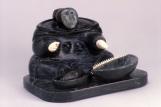1
excerpt from "Women of Stone: The 1950s" in "Guardians of Memory: Sculpture Women of Nunavik"1998
WOMEN OF STONE: THE 1950s
An excerpt from "Women of Stone: The 1950s" in Guardians of Memory: Sculpture Women of Nunavik, by Céline Saucier, published in 1998 by Les éditions de L'instant même, Quebec, p. 102. Saucier discusses Inukjuak carver Elijassiapik's Mother and Child with Qulliq (c.1955).
A woman working, with a child in her hood - this is the first thing one sees in this sculpture by Elijassiapik. But the many materials that went into its making are also significant. These elements contribute to our appreciation of the piece, which calls for a fairly complex interpretation, as can be seen in details such as the position of the arms in mid-air and the utilitarian objects placed in the foreground. The components of this carefully constructed scene give the piece its title and, through the artistry of the carver, express a trilogy. The woman, her child and the qulliq represent warmth and light united in the permanence of life. The fish placed in the vessel before her is a symbolic representation of subsistence. Combining symbols and figures, the artist conveys his love of the visual by working with no less than five materials, used in various proportions.
For in interpreting the piece, we must deal not only with the symbolism just mentioned, but also with the multiple materials used. In this skillfully executed work, the artist has freely exploited the possibilities of visual appeal by combining many tones and enhanced the volumetric effect by defining three distinct masses. The face, in a softer shade than the rest, balances the full, dark mass of the polished green stone and harmonizes with the ivory hands, which are chiseled in a supple way and rendered with a rare concern for realism. Attention is drawn to the woman's right hand by the wick held between her flingers. The whiteness of the ivory used for a saw-toothed decorative edge along the side of the qulliq echoes the surfaces of the hands and face. The woman's facial expression is rendered in such a way that the forehead is eclipsed by the strong line of the nose, which adds to the figure's vitality. The rest of the features on this affable face consist of eye sockets coloured in a darker tone, slightly rounded cheeks and a mouth represented without detail.
The roundness of the volume, which comes from the figure's squat position, is reinforced by the presence of the child carried in the hood. The woman is sitting, her amauti covering her completely, and her bosom is accentuated. The neck opening of the garment is, as in many other sculptures, very wide and lies flat on her shoulders in a rimmed circle. The child is placed within this circle, with his face close to the woman's; the expression on this face is lightly sketched and no other material is used to make it more specific.
With this sculpture made in the mid-1950s, Elijassiapik gave us keys which, if used with a certain dispassion, open the doors to understanding works of dense content.
Credits:Les éditions de L'instant même
